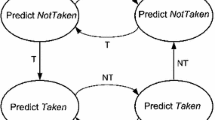Abstract
Microarchitects should consider power consumption, together with accuracy, when designing a branch predictor, especially in embedded processors. This paper proposes a power-aware branch predictor, which is based on the gshare predictor, by accessing the BTB (Branch Target Buffer) selectively. To enable the selective access to the BTB, the PHT (Pattern History Table) in the proposed branch predictor is accessed one cycle earlier than the traditional PHT if the program is executed sequentially without branch instructions. As a side effect, two predictions from the PHT are obtained through one access to the PHT, resulting in more power savings. In the proposed branch predictor, if the previous instruction was not a branch and the prediction from the PHT is untaken, the BTB is not accessed to reduce power consumption. If the previous instruction was a branch, the BTB is always accessed, regardless of the prediction from the PHT, to prevent the additional delay/accuracy decrease. The proposed branch predictor reduces the power consumption with little hardware overhead, not incurring additional delay and never harming prediction accuracy. The simulation results show that the proposed branch predictor reduces the power consumption by 29–47%.
Similar content being viewed by others
References
Parikh D, Skadron K, Zhang Y et al. Power issues related to branch prediction. In Proc. 8th Int. Symp. High-Performance Computer Architecture, Boston, USA, Feb. 02–06, 2002, pp.233–242.
ARM Corp. ARM1136J(F)-S. Available at http://www.arm.com/products/CPUs/ARM1136JF-S.html
ARM Corp. ARM1156T2(F)-S. Available at http://www.arm.com/prod-ucts/CPUs/ARM1156T2-S.html
Manne S, Klauser A, Grunwald D. Pipeline gating: Speculation control for energy reduction. In Proc. 25th Int. Symp. Computer Architecture, Barcelona, Spain, June 27–July 1, 1998, pp.132–141.
Hu Z, Juang P, Skadron K et al. Applying decay strategies to branch predictors for leakage energy savings. In Proc. 20th Int. Conf. Computer Design, Freiburg, Germany, Sept. 16–18, 2002, pp.442–445.
Petrov P, Orailoglu A. Low-power branch target buffer for application-specific embedded processors. In Proc. Euromicro Symp. Digital System Design, Belek, Turkey, Sept. 1–6, 2003, pp.158–165.
Palermo G, Sami M, Silvano C et al. Branch prediction techniques for low-power VLIW processors. In Proc. 13th ACM Great Lakes Symp. VLSI, Washington DC, USA, April 28–29, 2003, pp.225–228.
Monchiero M, Palermo G, Sami M et al. Power-aware branch prediction techniques: A compiler-hints based approach for VLIW processors. In Proc. 14th Great Lakes Symp. VLSI, Boston, USA, April 26–28, 2004, pp.440–443.
Chaver D, Pinuel L, Prieto M et al. Branch prediction on demand: An energy-efficient solution. In Proc. Int. Symp. Low Power Electronics and Design, Seoul, Korea, Aug. 25–27, 2003, pp.390–395.
Huang M C, Chaver D, Pinuel L et al. Customizing the branch predictor to reduce complexity and energy consumption. IEEE Micro, 2003, 23(5): 12–25.
Parikh D, Skadron K, Zhang Y et al. Power-aware branch prediction: Characterization and design. IEEE Trans. Computers, 2004, 53(2): 168–186.
Jimenez D A. Reconsidering complex branch predictors. In Proc. 9th Int. Symp. High-Performance Computer Architecture, Anaheim, USA, Feb. 8–12, 2003, pp.43–52.
Jimenez D A, Keckler S W, Lin C. The impact of delay on the design of branch predictors. In 33rd Proc. Int. Symp. Microarchitecture, Monterey, USA, Dec. 10–13, 2000, pp.67–76.
McFarling S. Combining branch predictors. In WRL Technical Note TN-36, Digital, 1993.
Samsung Electronics. Samsung Memory Compiler. 2002.
Seal D. ARM Architecture Manual. 2nd Edition, Addison-Wesley Longman Publishing Co., 2000.
Standard Performance Evaluation Corp. SPEC CPU2000 Bench-marks. Available at http://www.specbench.org/osg/cpu2000.
Lee C, Potkonjak M, Mangione-Smith W. MediaBench: A tool for evaluating synthesizing multimedia and communication systems. In Proc. 30th Int. Symp. Microarchitecture, Research Triangle Park, USA, Dec. 1–3, 1997, pp.330–335.
Burger D, Austin T M, Bennett S. Evaluating future microprocessors: The SimpleScalar toolset. Tech. Report TR-1308, Computer Science Dept., Univ. Wisconsin-Madison, 1997.
Author information
Authors and Affiliations
Corresponding author
Additional information
This work was supported by the BK21 Project.
Cheol Hong Kim received the B.S. degree in computer engineering from Seoul National University, Seoul, Korea in 1998 and M.S. degree in 2000. He is currently a Ph.D. candidate in the Department of Electrical Engineering and Computer Science at Seoul National University. His research interests include computer architecture, low power system and multiprocessors.
Sung Woo Chung received the B.S. and M.S. degrees in computer engineering, and the Ph.D. degree in electrical and computer engineering from Seoul National University, Seoul, Korea in 1996, 1998, and 2003 respectively. He worked as an academic visitor for IBM T.J. Watson Research Center in Yorktown Heights, NY, USA from Jan. 2002 to July 2002. He worked as a senior engineer for Processor Architecture Laboratory in Samsung Electronics, Korea from Jan. 2003 to Feb. 2005. Now he is working as a Post-Doctor in Department of Computer Science, University of Virginia, USA. His research interests include microarchitecture, cache management, system architecture, parallel architecture and low-power design.
Chu Shik Jhon received the B.S. degree in applied mathematics from Seoul National University, Seoul, Korea in 1975, the M.S. degree in computer engineering from Korea Advanced Institute of Science and Technology, Daegeon, Korea in 1977, and the Ph.D. degree in computer engineering from the University of Utah in 1982. He was an associated professor in Computer Engineering Department at Iowa State University from 1983 to 1985. He is currently a professor in the Department of Electrical Engineering and Computer Science at Seoul National University. His research interests include computer architecture, parallel computing, and VLSI design automation.
Rights and permissions
About this article
Cite this article
Kim, C.H., Chung, S.W. & Jhon, C.S. A Power-Aware Branch Predictor by Accessing the BTB Selectively. J Comput Sci Technol 20, 607–614 (2005). https://doi.org/10.1007/s11390-005-0607-y
Revised:
Issue Date:
DOI: https://doi.org/10.1007/s11390-005-0607-y




